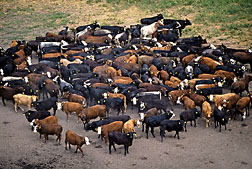This page has been archived and is being provided for reference purposes only. The page is no longer being updated, and therefore, links on the page may be invalid.
| Read the magazine story to find out more. |
|
|
|
|
Researchers Uncover Genetic Link to Cattle Diseases
By Sandra AvantSeptember 8, 2011
The origin of three costly cattle diseases is genetically linked, according to findings from U.S. Department of Agriculture (USDA) researchers.
Scientists at the Agricultural Research Service (ARS) Roman L. Hruska U.S. Meat Animal Research Center (USMARC) in Clay Center, Neb., have discovered a location on bovine chromosome 20 that is associated with the incidence of the most prevalent bacterial diseases—pinkeye, foot rot and bovine respiratory disease (pneumonia)—that affect feedlot cattle.
ARS is USDA's chief intramural scientific research agency, and this research supports USDA's priority of promoting international food security.
Bovine respiratory disease accounts for 75 percent of feedlot illnesses and up to 70 percent of all deaths, with economic losses to cattle producers exceeding $1 billion annually. The estimated costs for pinkeye are $150 million yearly, and losses to dairy producers due to foot rot range from $120 to $350 per animal.
Eduardo Casas, research leader of the Ruminant Diseases and Immunology Research Unit at the ARS National Animal Disease Center in Ames, Iowa, and a former USMARC geneticist, examined the genetic makeup of cattle for evidence of genes associated with resistance or tolerance to diseases.
Casas and his colleagues combined pinkeye, foot rot and bovine respiratory disease to represent overall pathogenic disease incidence. They developed half-sibling families from crossbreed bulls: a Brahman-Hereford, a Brahman-Angus, a Piedmontese-Angus and a Belgian Blue-MARC III (part Red Poll, Pinzgauer, Hereford and Angus). An analysis of DNA samples from the 240 offspring infected with one or more of the diseases revealed a genetic marker, called a quantitative trait locus (QTL), on chromosome 20. This QTL is associated with the three diseases.
Chromosome 20 is located near genetic markers related to other diseases and may have a significant effect on the overall health of cattle, according to Casas. Identifying genetic markers responsible for disease would provide an opportunity to produce cattle with increased disease tolerance, which also could help reduce economic loss associated with diseases.
Results from the research were published in the Journal of Animal Science.
Read more about this research in the September 2011 issue of Agricultural Research magazine.

